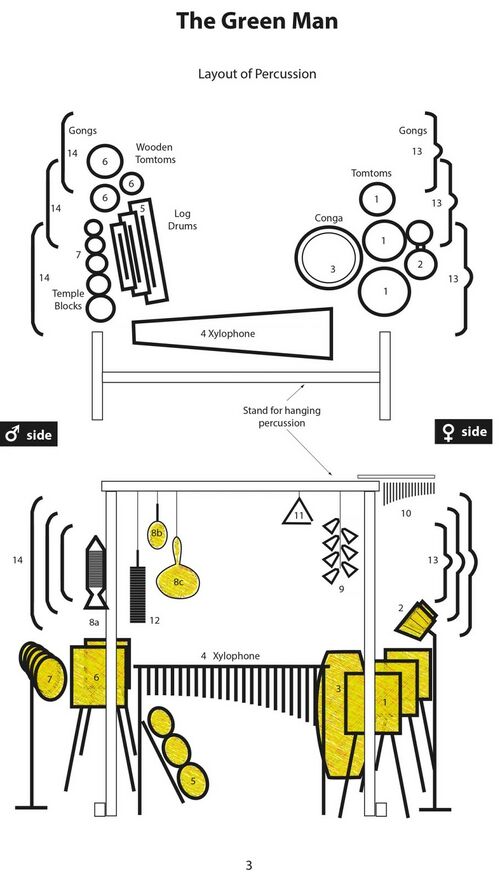The Green Man
General Info
Year: 1988
Duration: c.
Difficulty: (see Ratings for explanation)
Publisher: Waiteata Press
Cost: Score and Parts - $0.00 | Score Only - $0.00
Movements
Instrumentation
Multiple Percussion: 1. 3 tomtoms, 2. pair of bongos, 3. conga, 4. xylophone, 5. 3 log drums, 6. 3 wooden tomtoms, 7 5 temple blocks, 8a. guiro, 8b. maraca, 8c. cabasa, 9. string of small bells, 10. small chimes, 11. triangle, 12. kokoriko, 13. 3 gongs, 14. 3 tamtams
Program Notes
The idea for the percussion piece The Green Man comes from Michael Harlow’s poem; No Problem, But Not Easy : what seems to be a man is, depending on how we observe him, sometimes a woman. This Jungian theme appears frequently in Michael’s work, also, for example, in the cycle of poems previously set by me, Poem then, for love which also uses much the same percussion instruments as The Green Man.
No Problem, But Not Easy
This is the Green Man
He lives at the corner of Hello Street and Goodbye.
He lives in a house, Alchemy House.
When you stand close to him
He is surely a man, you can see that
Sometimes, even, he has a beard.
And there are times when you see him
From afar, say, from across the room
He is also a woman.
Now, she is the Green Woman.
This is the way it is.
Sometimes he is friendly
Always in a hurry to be singing.
Sometimes she is not unfriendly
She is full of lightness, and music.
And there are times when he is quite terrible
Full of fire, you had better watch out.
And sometimes she is quite bossy
Even wicked, be careful.
Which is the way it is.
And you know, sometimes even they go to war.
There is destruction all over the place.
And of course there are times
When they lie down in each other’s arms
And they touch each other again and again.
And this is the way it is:
No problem, but not easy.
Michael Harlow Giotto’s Elephant, John McIndoe, Dunedin, New Zealand 1991 N.B.: The piece of music: The Green Man was written in 1989 based on a poem by the same name. This poem was renamed and published in 1991 as shown here.[1]
Theatrical Elements:
The Percussionist (plus instruments) is the Green Man. He or she need not be coloured green nor need he or she show any special masculinity or femininity. What is important in a performance however is that the audience be aware of these opposites among the instruments and tension between them. The opposites are shown in the score as “male” and “female” groups of instruments (to the player’s left and right respectively) separated by the xylophone in the middle. Christoph Caskel, who played the first performance of this work in September 1989 pointed out that the skin drums with their military connotations were for him rather masculine and the wooden instruments rather feminine. Although his critisism would be shared by many, the important thing is not which side is which, but that there are two contrasting sides separated by the xylophone in the middle. This “trinity” of instruments forms the cast of a sort of concerto grosso where left and right are the soloists and the xylophone is the ripieno. The xylophone introduces us to the protagonists who then encounter each other: they fight, love and finally fuse into an entity which also includes the xylophone.
Review
Errata
Awards
Commercial Discography
Online Recordings
Recent Performances
To submit a performance please join the TEK Percussion Database
Works for Percussion by this Composer
Concerto for 5 Percussionists and Orchestra - Percussion Quintet, Orchestra
Devotion to the Small - Percussion Quintet, Soprano Voice
The Green Man - Multiple Percussion
Additional Resources
References
